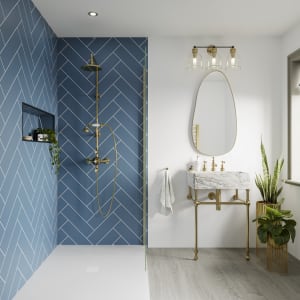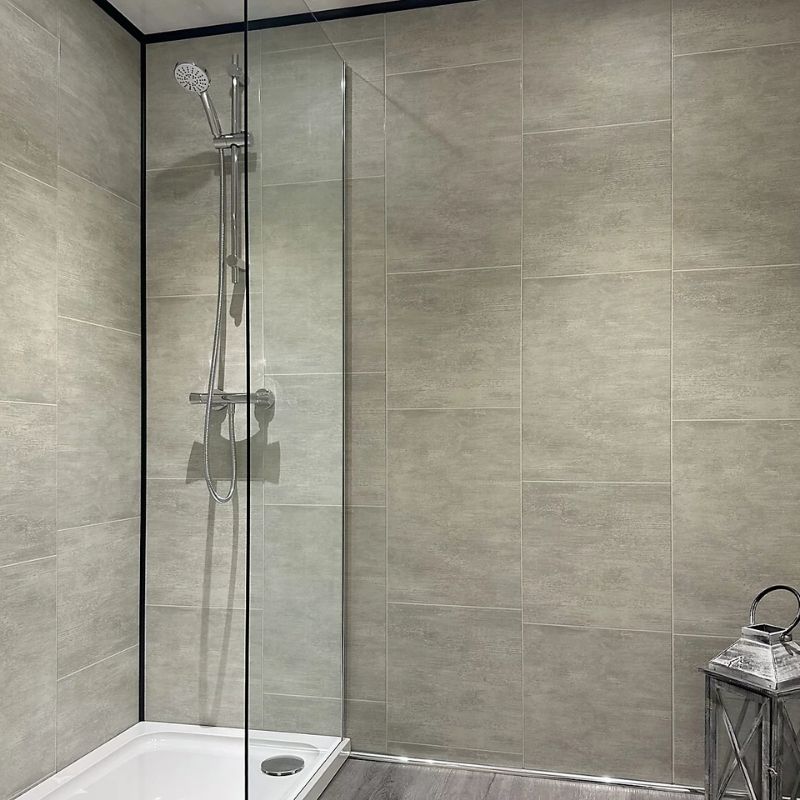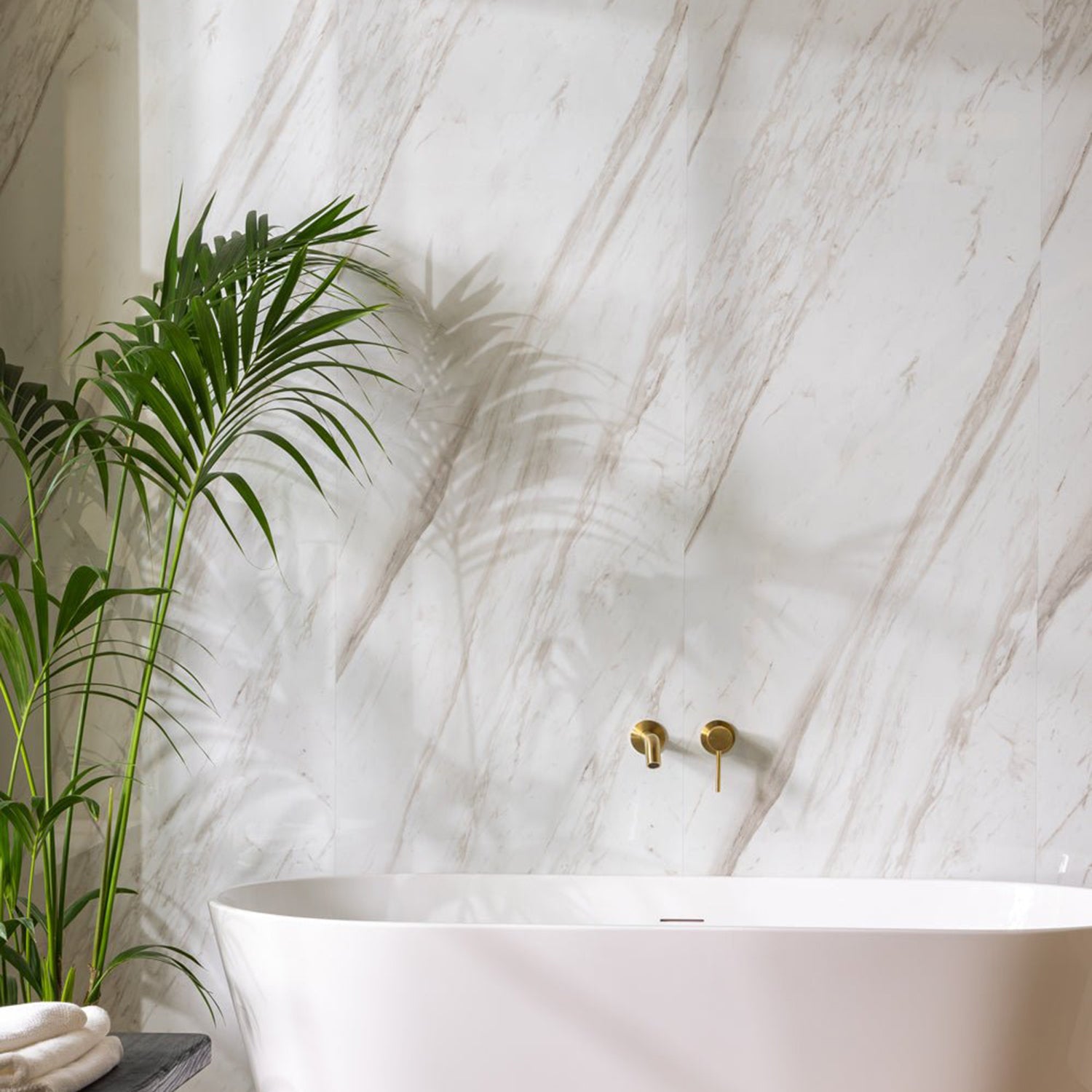13 wet wall bathroom ideas for a low maintenance and stylish alternative to tiles
Transform your bathroom with expert-approved wet wall ideas that are stylish, low-maintenance and anything but ordinary

- 1. Tile effect panels
- 2. Statement wall designs
- 3. Soft pastel shades
- 4. Dark wood effect
- 5. Light wood finishes
- 6. Marble effect panels
- 7. Luxurious finishes
- 8. Match walls with floors
- 9. Use colour and texture
- 10. Combine with clever lighting
- 11. Contrast materials
- 12. Opt for half wall panels
- 13. Style your bathroom in serene hues
- FAQs
Tiles may be the traditional go-to for bathroom walls and floors, but they're no longer the only option worth considering. Sleek, fuss-free and available in a huge array of designs, wet wall panels are fast becoming the modern renovator’s secret weapon. Not only do they sidestep the fuss and maintenance of grout lines, but they offer a stylish and low-maintenance alternative that’s easy to fit and even easier to live with.
But with so many finishes on the market, from marble-effect gloss to rustic wooden designs, narrowing down the right look can be surprisingly tricky. That’s why we asked bathroom designers to bring you 13 standout wet wall bathroom ideas to inspire your next renovation.
What to know before installing wet wall panels in a bathroom
"There are plenty of reasons to opt for wet wall panels over traditional bathroom tile ideas," explains Harriet Goodacre, style consultant at Topps Tiles. “Shower panels offer a seamless and consistent surface without grout lines and are an excellent alternative if you don't have the budget for extra-large tile slabs.”
“Wall panels are also easier to clean and maintain compared to wall tiles,” she continues. “They can be wiped down with standard household cleaners, and their non-textured surface prevents soap scum and grime from accumulating.”
However, there are a couple of downsides to consider, too. “While wall panels are often a more budget-friendly option, it's important to note that they typically have a shorter lifespan than tiles,” Harriet adds. You can usually expect wall panels to last between 10 and 15 years before they need replacing, though some premium brands offer warranties of up to 35 years.
“To ensure a professional finish for your wet wall panels, it's crucial to start with a flat wall surface,” cautions Harriet. “If your walls aren’t even, you’ll need to install a batten frame to support the panels. Keep in mind that this can take up valuable space in a small bathroom and add to your overall bathroom renovation costs due to the additional materials and installation.”

Since joining the Topps Tiles brand in 2013 Harriet has delved into all things interiors, from designing sets for lifestyle photoshoots to commentating on the latest trends to the UK press.
1. Get the best of both worlds with a tile effect wet wall panels
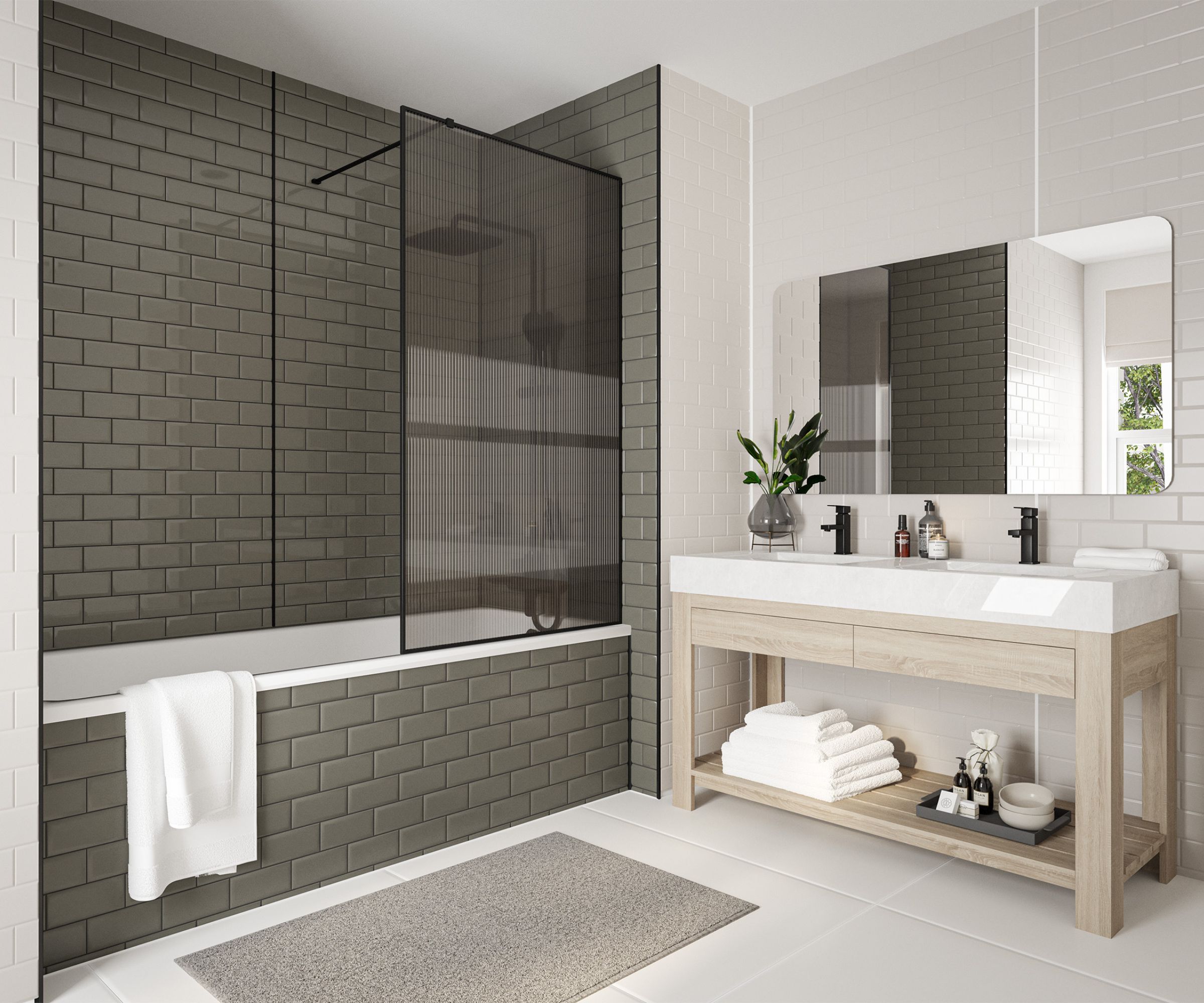
If you love the classic charm of tiled bathrooms, but not the hassle that comes with learning to tile, then tile effect wall panels offer the perfect compromise. Whether you're drawn to versatile subway designs or more intricate herringbone patterns, these panels make it possible to replicate the look of real tiles without any of the mess and maintenance involved.
Bring your dream home to life with expert advice, how to guides and design inspiration. Sign up for our newsletter and get two free tickets to a Homebuilding & Renovating Show near you.
Harriet Goodacre explains: "Unlike regular tiles, which require meticulous grouting and can be time-consuming to fit, wall panels feature a tongue and groove joint system that allows for quick and straightforward assembly. This not only reduces installation time but also minimises disruption during bathroom renovations."
Shop tile effect wall panels
2. Go all out with a statement wall design
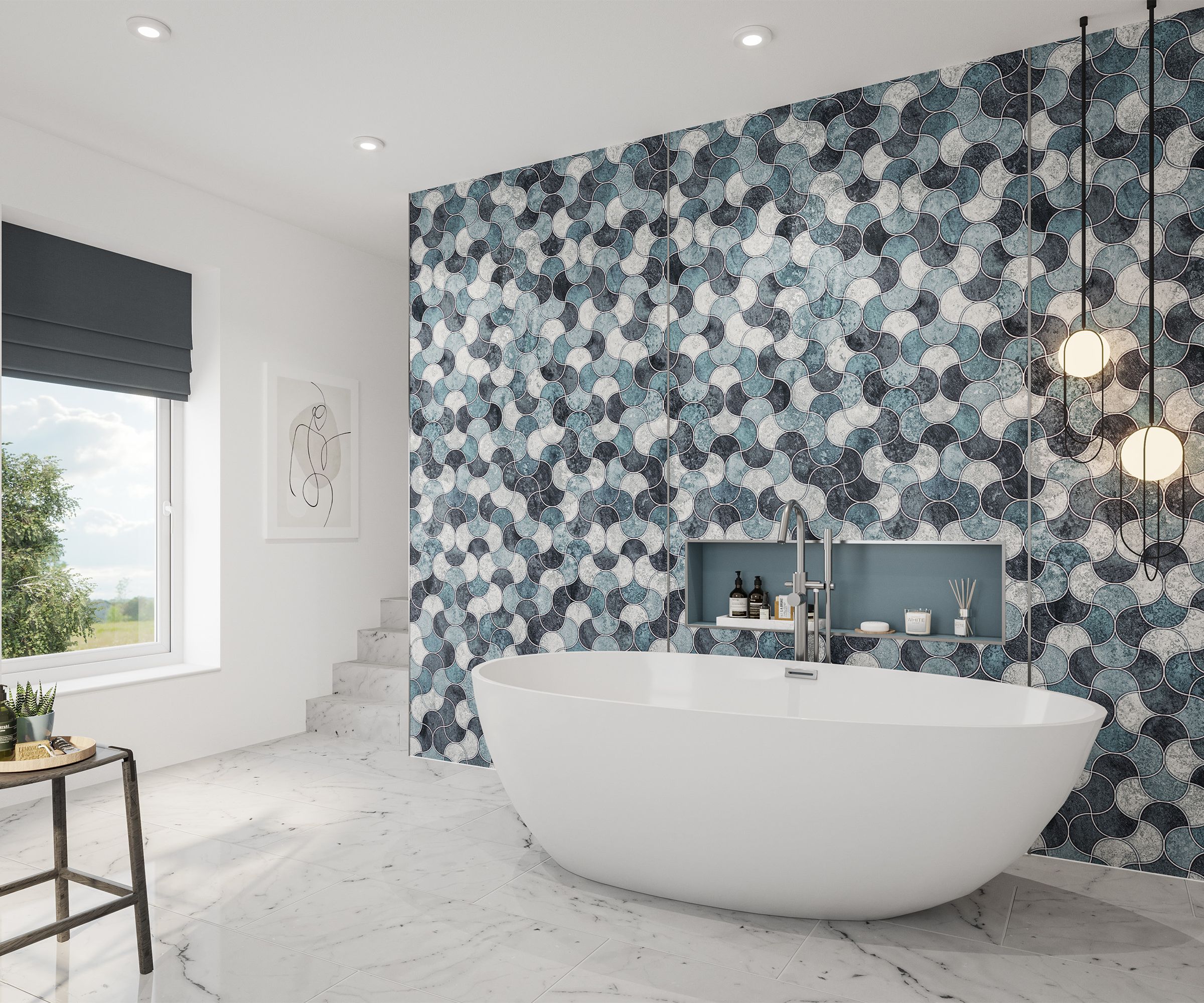
“Statement designs are taking centre stage this year, driven by homeowners transforming everyday spaces into eye-catching retreats," explains Emma-Louise Braham, product design expert at Wetwall™. "Consider oversized, bold patterns and intricate mosaics that serve as the room’s main feature, rather than just background décor."
"Designs with striking textures, like 3D effects or glossy metallic finishes, will add a touch of luxury and character to your bathroom," she continues. The room pictured above shows just how effective this approach can be. The swirling mosaic-style wall panels instantly catch the eye, injecting energy and texture into the room. Paired with sleek marble-effect floor tiles and crisp white walls, the statement feature brings the whole space to life on a relatively small budget.

Emma-Louise Braham is product design expert at Wetwall™, where she leads on developing trend-driven wall panel collections that combine style, innovation and practicality for modern bathrooms.
3. Opt for soft pastel shades
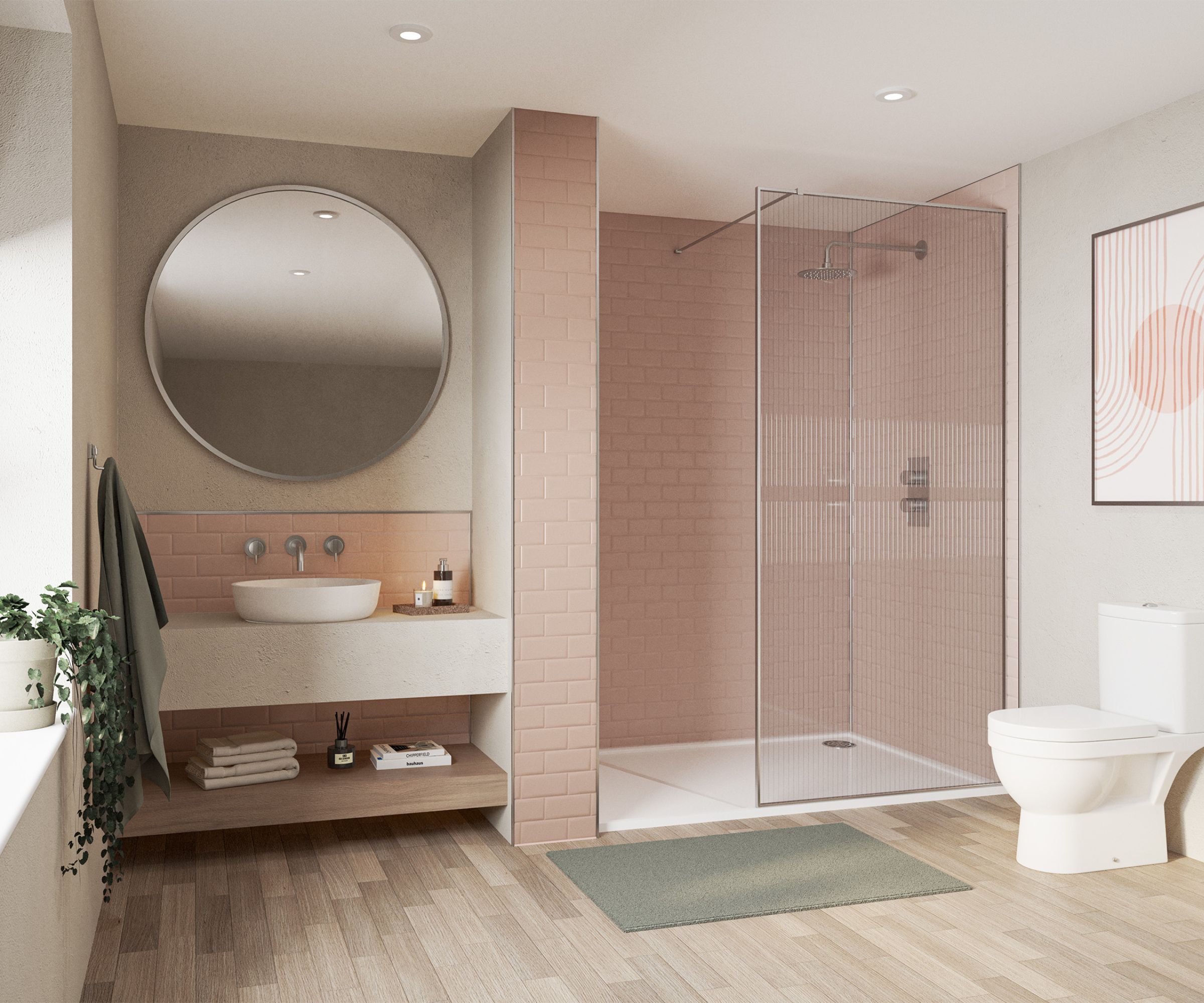
If you’re aiming for a bathroom that feels calm, fresh and just a little bit playful, pastel shades are a great place to start. Gentle tones like blush pink, powder blue or mint green lend themselves beautifully to shower rooms, helping to soften these otherwise functional spaces.
In the bathroom pictured above, blush pink wall panels add some much needed character to a modern bathroom. The subtle brick-effect design offers just enough texture to catch the eye, while the muted palette keeps things feeling open and serene. Combined with pale laminate bathroom flooring and soft neutral walls, this bathroom is proof that pastel shades don’t have to look overly sweet, as they can feel chic and contemporary when done right .
4. Embrace dark wood effect panels for a rustic finish
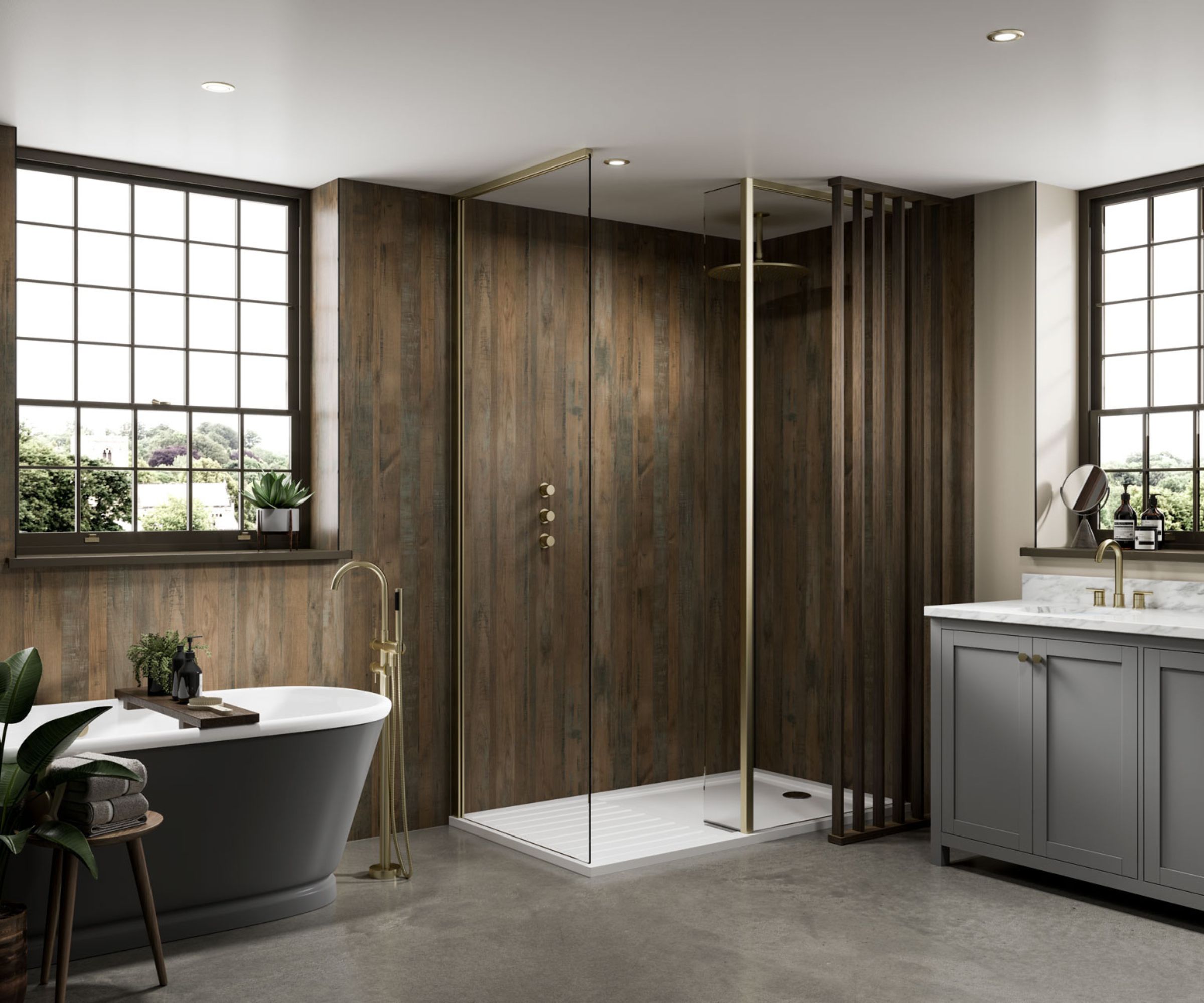
"Wood-effect panels are gaining traction, mirroring the popularity of acoustic wall panels in living areas," explains Harriet Goodacre at Topps Tiles. "These panels offer the aesthetic of real wood without the risk of warping or water damage, making them ideal for bathrooms."
"From a design perspective, natural-effect wood finishes brings a warm, organic feel to the bathroom, aligning with current trends that favour natural materials and textures," adds Hayley Bowman, design manager at Frontline Bathrooms. When paired with brushed brass fittings and soft, neutral cabinetry – like the design pictured above – you can create a bathroom that feels both modern and rustic, with a timeless appeal that won’t go out of style any time soon.

Hayley is Head of Marketing at Frontline Bathrooms and Smiths Briten, two of the UK’s leading bathroom distribution companies. She focuses on showcasing the quality and style of their products to retailers, tradesmen, and homeowners, helping them bring beautiful, functional spaces to life.
5. Try a light wooden finish for a softer aesthetic
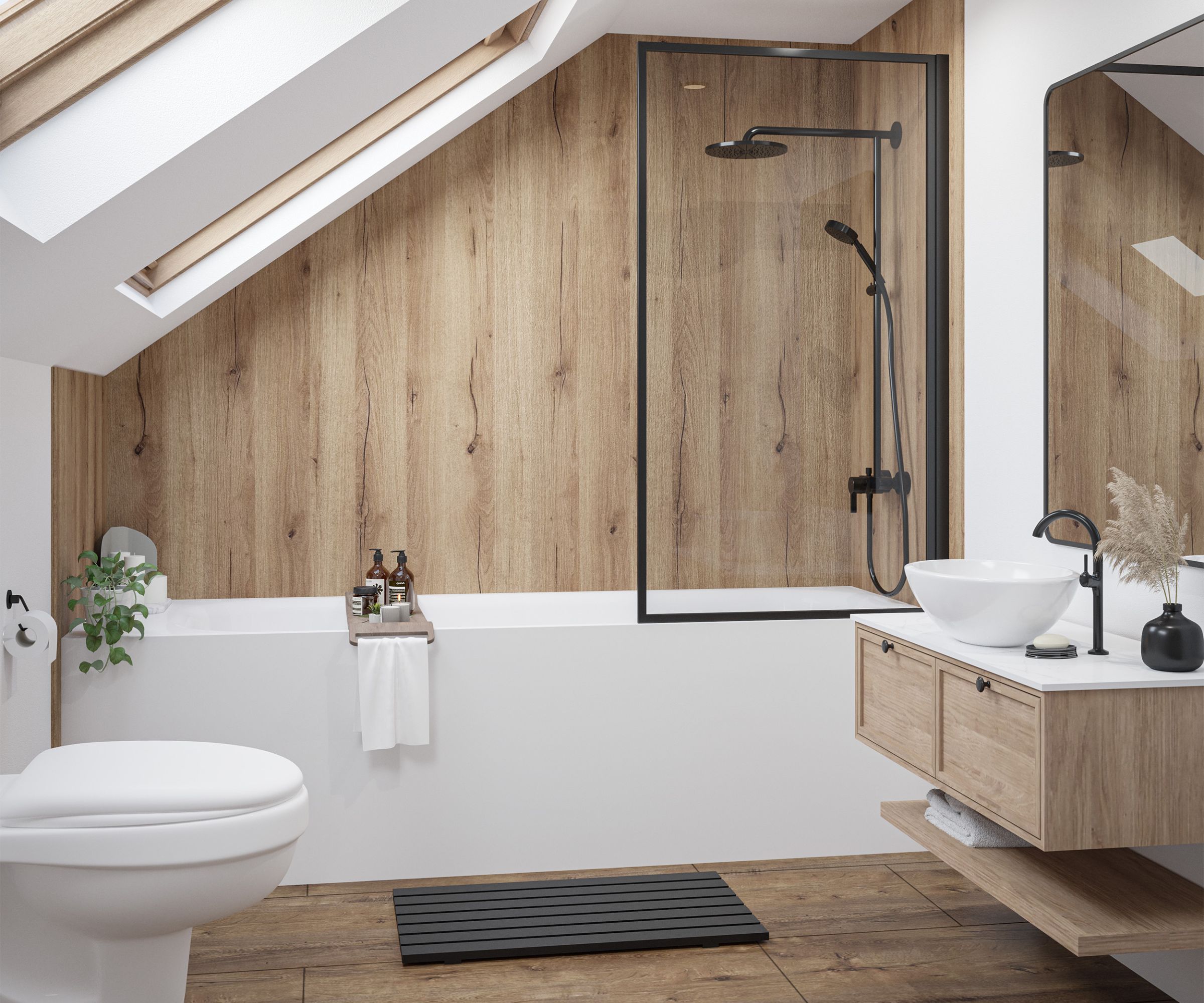
Not all wood-effect panels need to be dark and moody. If you're after a lighter, airier atmosphere, pale timber finishes offer the perfect balance between warmth and minimalism. In the loft conversion bathroom above, pale oak-effect wet wall panels are used to striking effect. The sloping ceiling is complemented by the soft grain and warm tone of the panels, creating a space that feels both modern and relaxed.
Light wood finishes work especially well in low-ceilinged or small bathrooms, where darker surfaces might feel too heavy. They can also lend these spaces a subtle Scandi-inspired edge, and can nicely replicate the style of Japanese bathrooms.
6. Use marble effect walls to step up your bathroom design
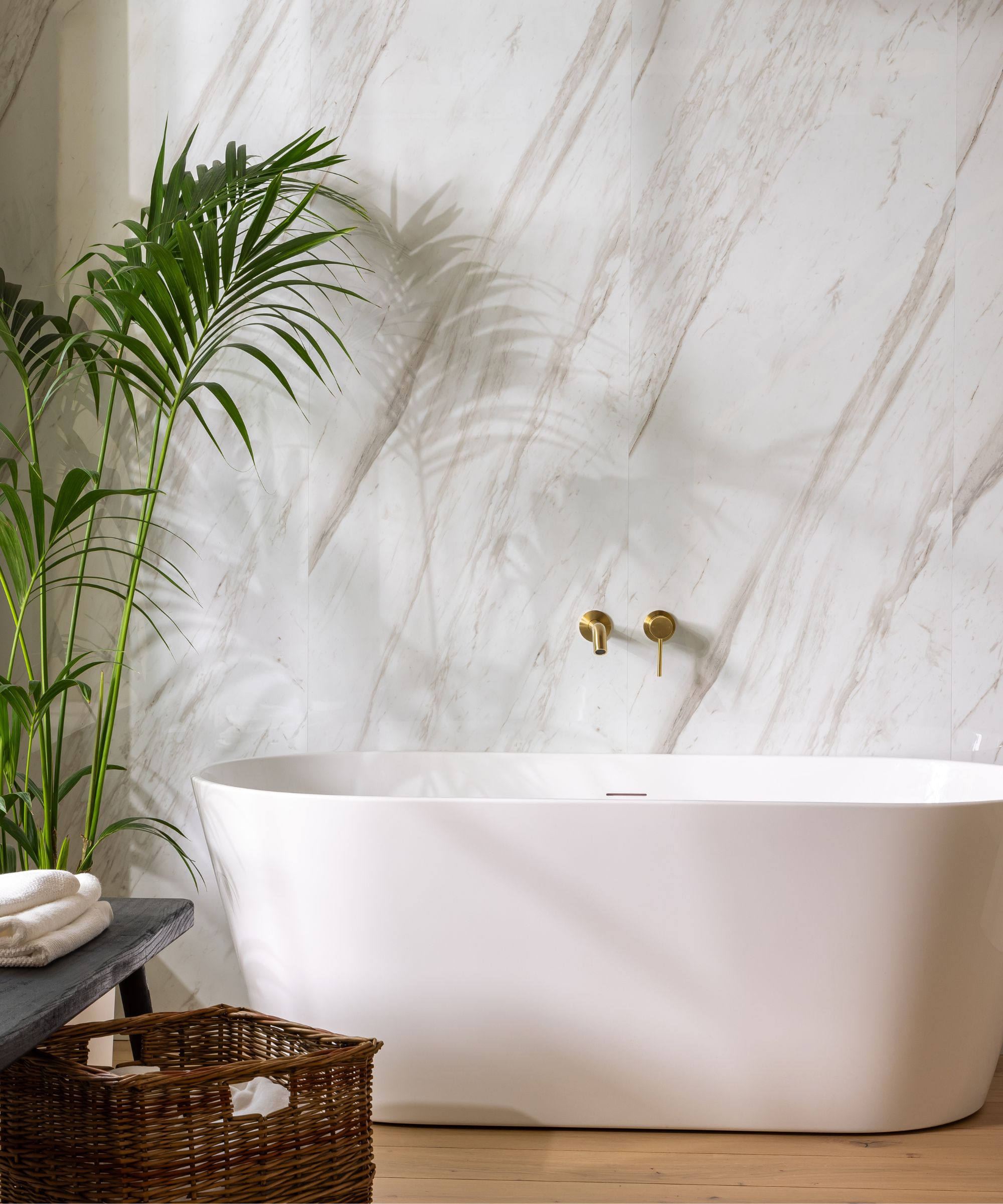
If there’s one material that never goes out of style, it’s marble. Whether real or replicated, marble effect wet wall panels add instant sophistication to a bathroom, with the added bonus of being far easier to install and maintain than the real thing.
“Marble designs remain a popular choice for adding a touch of luxury, with neutral colours continuing to dominate bathroom trends, creating a calming and versatile backdrop,” says Harriet Goodacre at Topps Tiles. "These soft, stone-inspired finishes work beautifully on walls, adding depth without overwhelming the space."
Emma-Louise Braham, product design expert at Wetwall™, agrees: “Marble, with its timeless appeal, serves as the perfect backdrop for lively colours. The natural veining and cool tones of the marble provide a sense of luxury and grounding, while the unexpected bursts of colour add energy and personality to the space.”
7. Use luxurious finishes to make a bold statement

If subtle isn’t your style, lean into the drama with wet wall panels that double as art. High-gloss finishes, bold colour palettes, and rich, swirling patterns can instantly elevate your bathroom, giving it the feel of a boutique hotel rather than a typical en suite.
In the design above, the walls take centre stage with a striking marbled pattern in dramatic tones of charcoal, stone, and caramel. This unique finish delivers serious wow factor without the upkeep or installation challenges that come with large-format tiles.
To keep a similar look feeling sophisticated rather than overwhelming, balance bold panels with minimal fittings and a restrained colour palette elsewhere. A sleek white vanity unit and pale floor tiles, for example, create breathing space and allow the feature wall to truly shine.
8. Match walls with floors for a seamless look
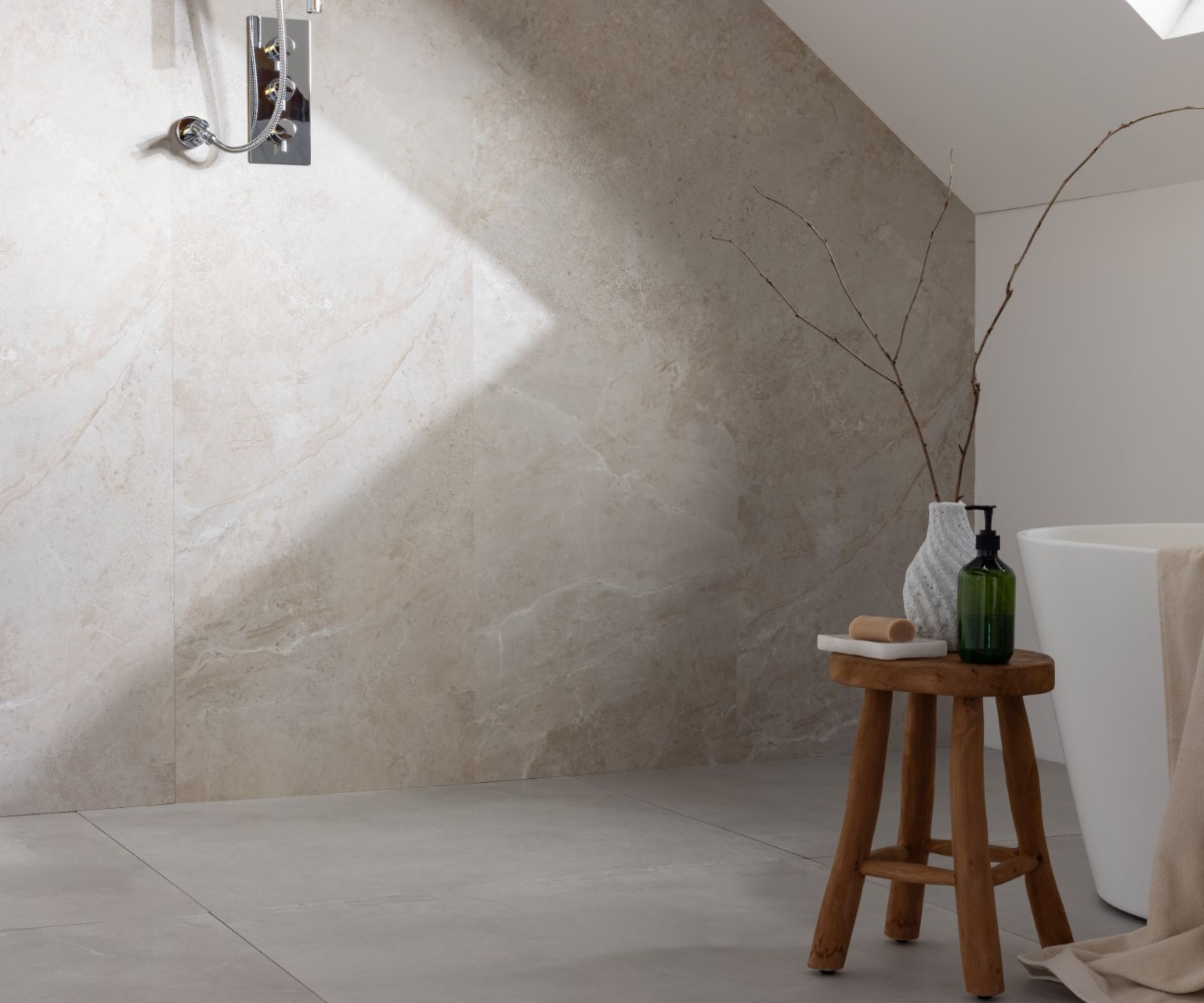
One of the simplest ways to create a cohesive bathroom is to blur the lines between different surfaces. Matching your wet wall panels to your flooring creates a seamless, look that makes the space appear larger, cleaner and more elevated. For example, in the example above by Naturewall, soft beige stone-effect panels flow effortlessly into cleverly coordinated floor tiles, with subtle veining adding just enough texture to keep the scheme from feeling flat.
This approach works especially well in wet rooms, where uninterrupted surfaces help accentuate architectural features and natural light. If you’re opting for this style of bathroom, try to keep matching accessories pared back and tonal to maintain the look's quiet sophistication.
9. Be brave with colour and texture

From tactile surfaces to rich, saturated hues, wet wall panels offer the perfect medium to explore both colour and texture in creative ways.
"Heavy texture, particularly fluted surfaces, will remain a key bathroom trend in 2025," predicts Katie Parry Stone, retail manager at Cosentino UK. “Panels with a ribbed or slatted finish can bring subtle movement to the walls, catching the light and adding depth without overwhelming the space. We’ve also continued to see homeowners become braver and bolder when it comes to design throughout the home – from experimenting with colour to embracing pattern – so it’s no surprise that we’re now starting to see more colour in the bathroom.”
In the bathroom above, terracotta-toned fluted panels lend this walk in shower warmth and interest. “Wide slat designs add a subtle architectural element, creating visual interest without overwhelming the space. This makes them suitable for a variety of bathroom styles, from minimalist to rustic,” explains Hayley Bowman, design manager at Frontline Bathrooms.

Katie is Retail Manager at Cosentino Group – a family-owned company that produces and distributes high value innovative surfaces for the world of design and architecture.
10. Combine wet wall panels with clever lighting ideas
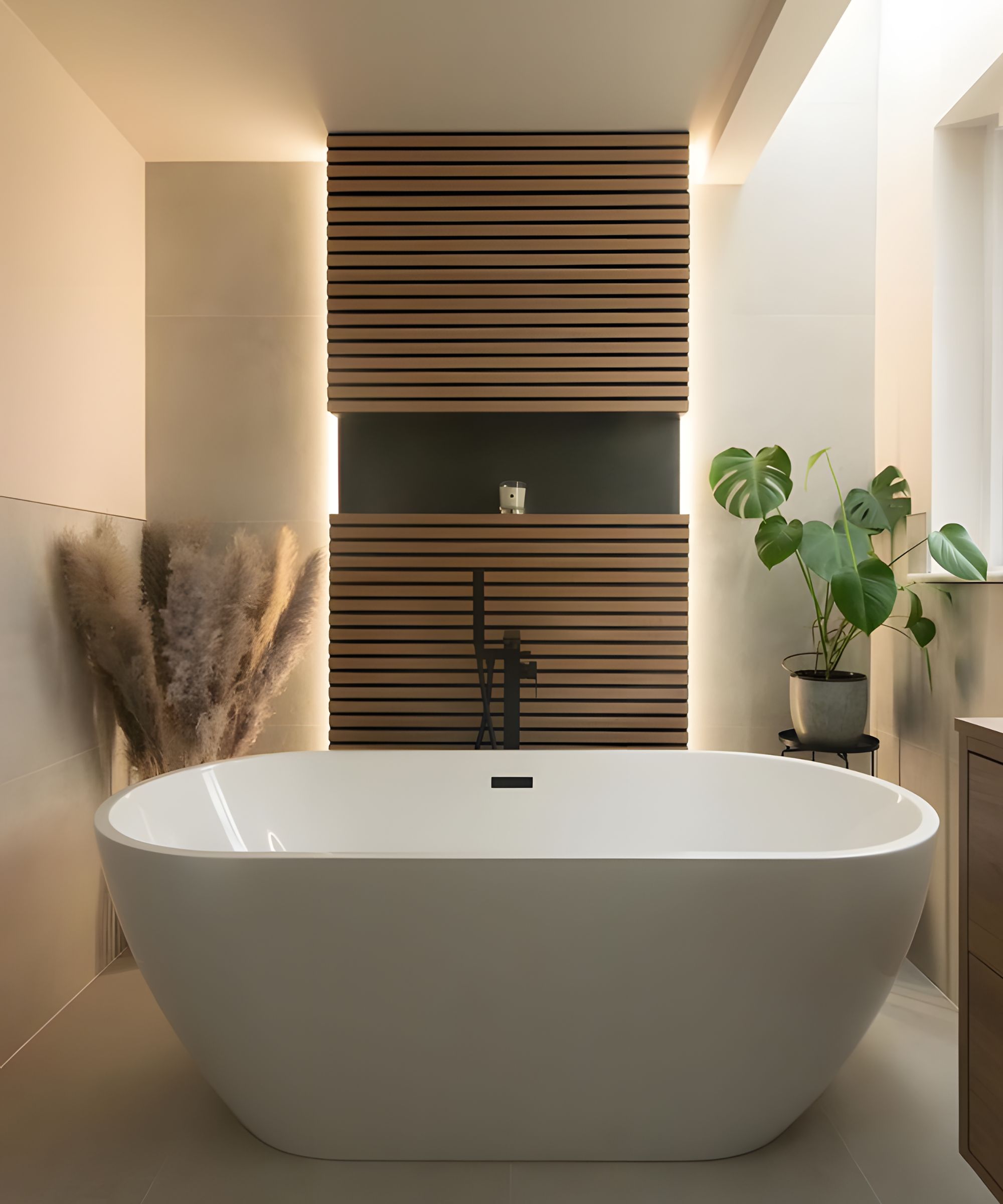
“Accent lighting and metallic details play a crucial role in adding a touch of glamour and warmth to bathrooms," says Emma-Louise Braham. For example, dimmable bathroom lights and LED strips can highlight textures and create a soft, ambient glow.
In the bathroom above, subtle backlighting brings out the texture of the slatted wood-effect panels and softens the edges of the freestanding bath to give the whole room a relaxing ambience. To recreate this look at home, combine task lighting with softer accent lights, such as LED strips tucked behind panels or under vanity units.
11. Contrast your choice of materials

One of the easiest ways to make a small bathroom feel luxurious is by playing with contrasting materials. Wet wall panels make it simple to mix different finishes and styles for a layered, bespoke feel that looks far more expensive than it actually is.
“Think about inventive pairings, like marble vanities set against concrete walls or wooden accents combined with glossy finishes,” recommends Emma-Louise Braham. “Mixed materials can be used to create focal points and add dimension, making bathrooms feel more bespoke and thoughtfully designed. By incorporating a variety of textures, designers can create spaces that are both contemporary and inviting.”
12. Play with the height of your wall panels
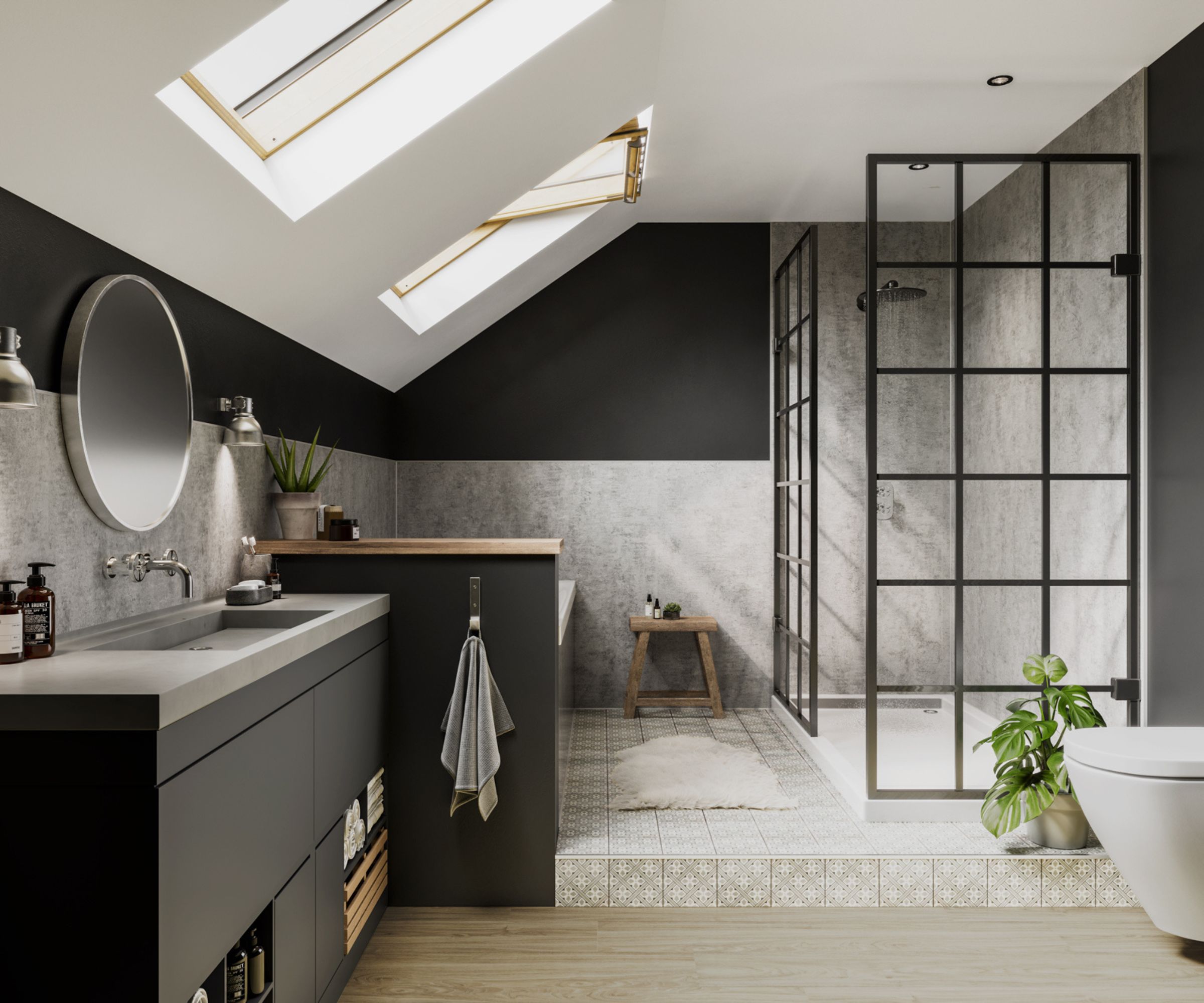
Rather than covering up an entire wall, consider stopping at mid-height with half wall panelling. In the bathroom above, the lower half is clad in soft grey panels, while the walls above are painted in a contrasting deep charcoal shade. This half-height approach helps break up expanses of wall and introduces a more 'tailored' feel to the space.
It’s also a great way to experiment with colour blocking or combine different finishes, such as paint or bathroom wallpaper. From a practical perspective, half-height panels are ideal for protecting splash zones behind basins or around baths, while allowing more decorative finishes higher up. Just remember to opt for full-height panels in areas like the shower, where surfaces are exposed to constant moisture and need to be fully waterproof.
13. Style your bathroom in serene hues
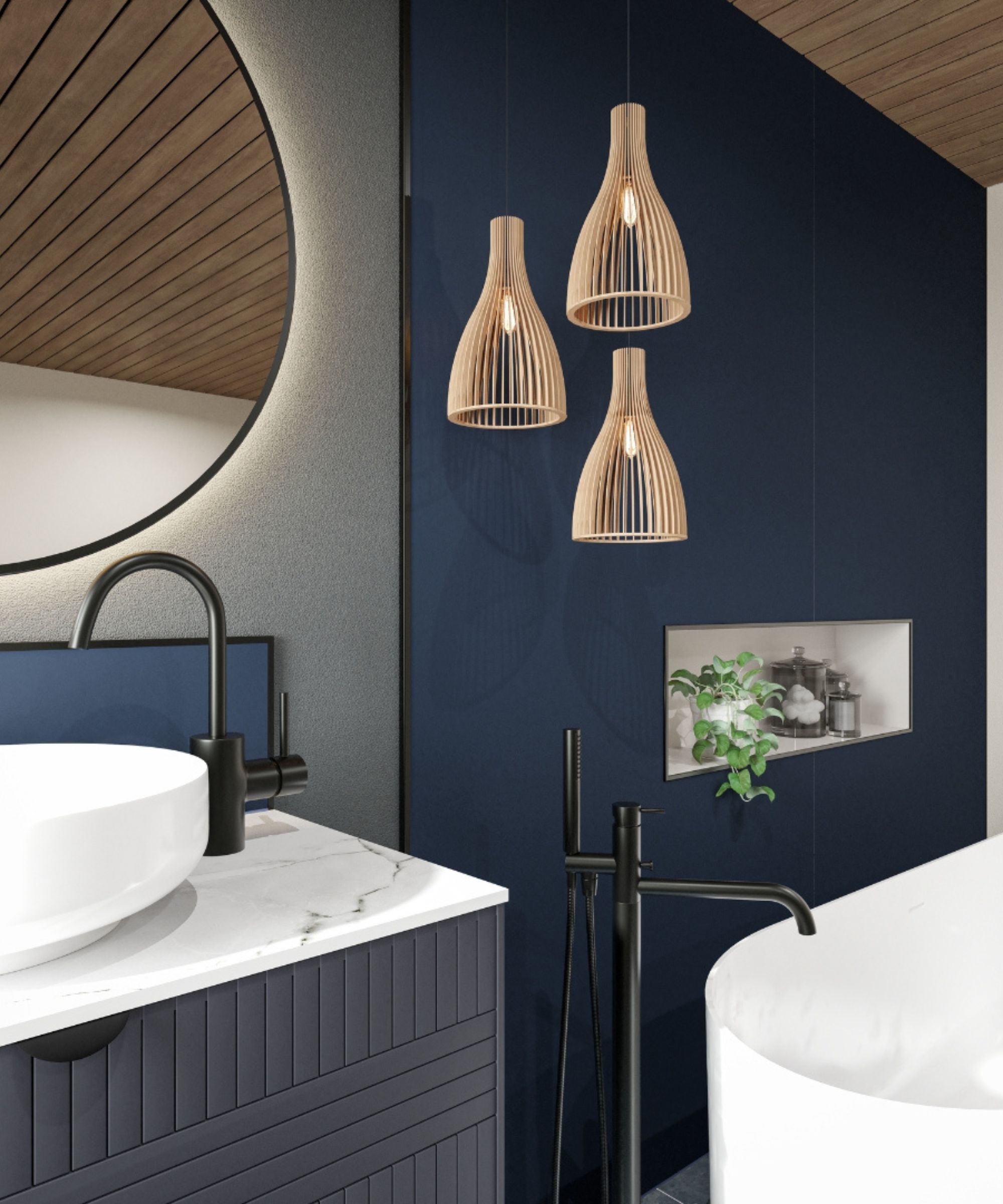
“Serene hues are set to remain a strong influence in bathroom design, with rich, immersive colours like midnight blue, charcoal grey and forest green leading the way,” predicts Emma-Louise Braham. “This trend reflects a growing desire to turn bathrooms into peaceful sanctuaries that offer a break from our busy lives."
"Midnight blue brings depth and calm, wrapping the room in a soothing, cocoon-like atmosphere," she continues. "Charcoal grey, with its moody elegance, introduces a sense of refined comfort. And forest green draws a direct line to nature, creating a grounding effect that makes the space feel connected, restorative and serene.”
FAQs
Below, we asked Emma-Louise Braham, product design manager at Wetwall™, to answer some of the most frequently asked questions about using wet wall panels in your bathroom.
Are bathroom wall panels better than tiles?
“Unlike traditional tiles, bathroom wall panels are grout-free, making them quicker to install and much easier to clean. This significantly reduces the time and effort needed to keep your bathroom looking pristine, while also avoiding common issues like mould and grout cracking. Their seamless installation is ideal for anyone wanting a fast, fuss-free refresh without the mess and downtime of tiling. Panels are often more cost-effective too, offering a sleek, modern look with minimal maintenance.”
Are wet wall panels 100% waterproof?
“Most wet wall panel systems are designed to be completely waterproof, helping to protect your bathroom walls from moisture damage caused by splashes and condensation. For the best results, choose panels made from materials like PVC, aluminium, or high-quality laminate, which are specifically engineered to withstand damp conditions. Just as important is following the manufacturer’s installation guidelines carefully, to ensure your panels deliver maximum protection against water ingress.”
Can wall panels be installed over existing tiles?
“In many cases, bathroom wall panels can be installed directly over existing tiles. Simply ensure the existing tiles are clean, intact, and level. Use a suitable adhesive to secure the panels and seal all edges to prevent water ingress. This can save the time and effort involved with removing old tiles.
However, before going ahead, ensure the tiles are adhered to walls, and there are no underlying issues like dampness, or structural problems that could affect the new installation. Any loose tiles must be removed, filled and sanded smooth. Wipe wall surfaces with a damp cloth and leave to dry prior to installation."
Are specialist tools required to install bathroom wall panels?
"Installing bathroom wall panels is a straightforward process, making them an ideal option for both quick updates and full renovations. Panels can be measured, cut, and fitted using basic tools – much like working with standard wood-based materials – which makes them accessible for confident DIYers as well as professionals. That said, precision is key. Accurate measuring and a steady hand are essential, particularly when cutting around tricky areas like windows, sockets or pipework.
To get started, you’ll need a few essential tools: a pencil, tape measure, drill, heavy-duty caulking gun, hole saw, circular saw with a fine-tooth blade, square, chalk line, heavy-duty suction cups, router, methylated spirit, and wooden shims."
Can you paint wet wall panels?
"No, wet wall panels are not designed for painting. Their surface is engineered to be water-proof and easy to clean, which can be compromised by paint. If you want to update the colour or style of your space, consider replacing the panels with new ones in your preferred design."
Choosing wet wall panels for you bathroom design scheme doesn’t mean you have to forgo tiles altogether. In fact, pairing panels with stylish bathroom floor tiles can create a beautifully balanced look.

Gabriella is an interiors journalist and has a wealth of experience creating interiors and renovation content. She was Homebuilding & Renovating's former Assistant Editor as well as the former Head of Solved at sister brand Homes & Gardens, where she wrote and edited content addressing key renovation, DIY and interior questions.
She’s spent the past decade crafting copy for interiors publications, award-winning architects, and leading UK homeware brands. She also served as the Content Manager for the ethical homeware brand Nkuku.
Gabriella is a DIY enthusiast and a lover of all things interior design. She has a particular passion for historic buildings and listed properties, and she is currently in the process of renovating a Grade II-listed Victorian coach house in the West Country.
